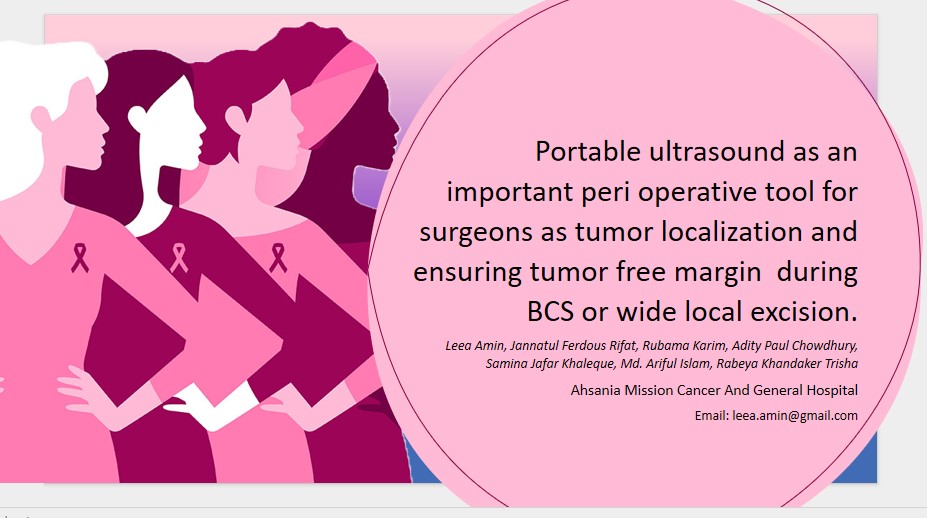Portable ultrasound as an important peri operative tool for surgeons as tumour localization and ensuring tumour free margin during BCS or wide local excision.
Authors: Leea Amin, Jannatul Ferdause Rifat , Rubama Karim, Adity Paul Chowdhury, Samina Jafar Khaleque, Arif, Rabeya Khandaker Trisha
Institution: Ahsania Mission Cancer and General, Uttara, Dhaka-1230
Introduction
Breast cancer is the second leading cause of cancer death in women in United states, third in UK and fifth in Asian Countries. Now a days, due to availability of different cost effective, user friendly portable ultrasound devices, a majority number of early breast cancer patients and high risk breast lesions undergo USG guided needle biopsy for diagnosis. Usually surgeons did not have access to ultrasound in the office or outpatient department or in clinic settings. For earlier detection of breast cancer and high risk lesions before they are palpable which causes a challenge for breast surgeons and require assistance from radiologists and sonologist colleague to localize breast lesions prior to excision. The commonest employed solution to this problem was pre operative needle localization which was performed by radiologists as pre operative wire localization (POWL). Wires, which serve as intra operative guidance to the lesion and typically placed by radiologists before and needs to be performed on the day of surgery to avoid wire migration due to patients movement . this results in a complex co ordination between the surgery and the radiology department and often results in operative room delays, cumbersome situation in maintaining OT schedules . There are many other innovative alternatives to POWL. They allow independent radiology and surgery scheduling and also decoupled from the surgical incision from localizing technique . but all these procedures are a little challenging for patients with low socio-economic status where health care cost is a major issue in their lives. Ultrasound guided blue dyed jelly injection around the lesion just prior to surgery can be a solution to this.
Methods
A retrospective study was done through hospital information system among patients undergone breast conserving surgery with SLNB or wide local excision with axillary sampling from January 2023 to January 2025. Follow up was confirmed both in persons and over phone calls . histopathologically tumour margins, number of Lymph nodes with metastasis, Lymph vascular involvements, presence of DCIS etc. were assessed.
Results
A total of 40 patients had undergone breast conserving surgery from January 2023 to January 2025 at AMCGH where ultrasound was used to define margins of the breast lesion pre-operatively by injecting blue dye mixed with lidocaine jelly. 20 patients completed one year following breast conserving surgery , 11 patients completed more than 6 months and 3 are very recent cases. Histopathologically, all showed tumour free margins a mean of 8 mm margin free of tumour. All the 40 patients were satisfied with the outcome and none choose to proceed for symmetrization of opposite breast. 6 patients presented with seroma following radiotherapy, 10 patients had skin thickening greater than 5 mm during follow up, 2 patients presented with superficial skin infection , managed by antibiotics.
Conclusion
However, even though there are many other innovative methods of tumor localization in case of breast conserving surgery all over the globe, they can’t always be implemented in developing Asian countries in their usual hospital setups. Increasing familiarity with and utilization of per-operative ultrasonography and injection of blue dyed jelly to locate the tumour during breast conserving surgery and assessing its resected margin may be clinically and economically beneficial over traditional localization technique and performing an oncologically safe surgery. Further large scale study and long term follow up will be required to validate these findings.
